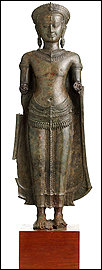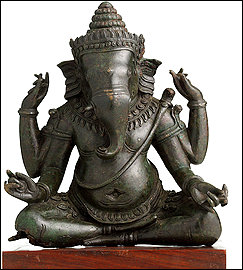Sackler Gallery
exhibits 'Gods of Angkor' bronzes from Cambodia
By Michael
O'Sullivan
Washington Post Staff Writer
Friday, May 28, 2010
There are only 36 works on display in the Arthur
M. Sackler Gallery's latest exhibition, "Gods of Angkor:
Bronzes From the National Museum of Cambodia." Maybe twice
that, if you count all the extra arms and heads


Gods, you see, are not like us.
The show -- a jewel box of mostly smallish sculptures in three
tiny galleries -- centers on devotional figures of Shiva, Vishnu
and other Hindu deities, several of whom are depicted with anywhere
from four to 10 arms, and as many as five heads. One, in the case
of Shiva's son Ganesha, has the head of an elephant.
There are also several statues of the Buddha.
I know: Buddha is not technically a god. Still,
he has often been revered as though he were one. And his various
bodhisattvas -- the quasi-human, quasi-godlike embodiments of
such virtues as wisdom and compassion -- are themselves considered
to be deities. (In an interesting twist on certain Western stereotypes,
wisdom, represented by the bodhisattva Prajnaparamita, is female;
compassion, in the person of Avalokiteshvara, is a male.)
So Buddha makes the cut. The show, which also features
two or three human figures, includes a number of rarely seen ritual
objects from Buddhist and Hindu worship: a bell, a mirror, a lotus
flower, a conch.
Yet despite its name, "Gods" isn't exactly a show about
religion. Nor is it simply a celebration of the bronze-caster's
art. Though it covers centuries' worth of art from the Khmer people
-- from late prehistory through the Angkor period (802 to 1431
A.D.) -- there's precious little technical information about how
the pieces were made.
Instead, the show is a tip of the hat from one museum to another.
One favor in exchange for another.
In 2005, experts from the Sackler helped set up the National Museum
of Cambodia's first metal conservation lab, with financial support
from the Getty Foundation. Today, in conjunction with its ceramics
and stone conservation shops, the Cambodian museum operates one
of Southeast Asia's preeminent art conservation facilities.
The beautiful works in "Gods of Angkor" are evidence
of that.
In other words, the National Museum of Cambodia got the gift,
but here in Washington, we are the beneficiaries.
http://www.washingtonpost.com/wp-dyn/content/article/2010/05/27/AR2010052701492.html
GODS OF ANGKOR: BRONZES FROM THE NATIONAL MUSEUM OF CAMBODIA
Through Jan. 23 at the Arthur
M. Sackler Gallery, 1050 Independence Ave. SW (Metro: Smithsonian).
202-633-1000 (TDD: 202-633-5285). http://www.asia.si.edu.
Hours: Open daily 10 a.m. to 5:30 p.m. Admission: Free.
May 15, 2010–January 23, 2011
Arthur M. Sackler Gallery
The fascinating story of bronze sculpture and casting in Cambodia
is revealed through thirty-six exceptional works. Magnificent
examples dating from the prehistoric period to the post-Angkorian
period (third century BCE to sixteenth century CE) present the
origins, uses, and techniques of bronze casting and the development
of a distinctly Cambodian style. This exhibition is the result
of an ongoing partnership between the Freer and Sackler Galleries
and the National Museum of Cambodia. The museums have worked together
to establish a metals conservation laboratory in Cambodia, the
first in that nation. Seven of the works on view, discovered in
2006, are among the first bronzes conserved in the lab by the
staff of the National Museum. Gods of Angkor travels to the Getty
Center of the J. Paul Getty Museum in Los Angeles in early 2011.